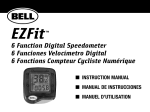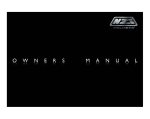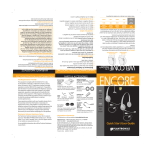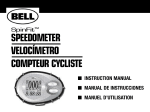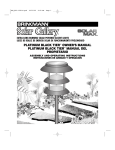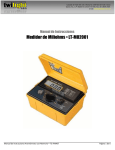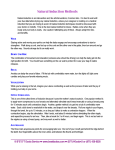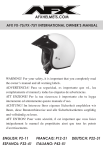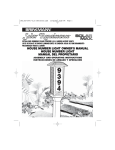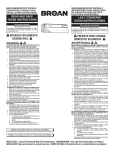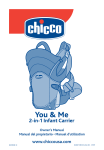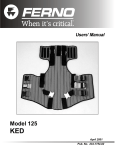Download 11” 8.5” Keyline does NOT PRINT
Transcript
FOLD Keyline does NOT PRINT 11” FOLD ENGLISH Fit Check List WARNINGS • Impact forces, even in a common low speed accident, can result in serious injury or death, even when a helmet is worn. • Helmets can’t prevent all head injuries. Brains can be injured through rotational motions, which helmets cannot prevent. • A helmet can only help protect what it covers. Use it every time you ride. Úselo cada vez que se sube a su bicicleta. BICYCLE HELMET Owner’s Manual For Dial Fit ™ Helmets YOU SHOULD ALWAYS: • Wear your helmet low in the front to protect the forehead. • Fasten the buckle and check strap adjustment often. • Replace your helmet immediately if it shows any visible signs of damage. • Clean your helmet with mild soap and water only. • Store your helmet in a cool dry place. • Ride safely, and obey all traffic laws. EYES YOU SHOULD NEVER: EYES: The rim of the helmet should be 1-to-2 finger-widths above the eyebrows. • Wear anything under your helmet. • Wear a bicycle helmet while on a motor vehicle. • Attach anything to your helmet. • Let your child play with a helmet, as they may damage it. • Wear a helmet that does not fit or cannot be adjusted properly. • Leave a helmet in direct sun or in a car on a sunny day. Do not use heat-damaged helmets. • Wear a helmet while climbing, as the helmet may snag, resulting in strangulation. CASCO DE BICICLETA Manual del propietario Para Cascos Dial Fit ™ OJOS: El borde del casco debe quedar a uno o dos anchos de dedo por arriba de las cejas. OJOS HELMETS WITH VISORS EARS Some helmets come with removable snap-on visors. To remove the visor, pull the ends of the visor loose from the helmet and then lift away from the helmet. To replace the visor, center it on the helmet and then snap the pins (A) on the visor into the holes (B) in the helmet. DO NOT try to remove the visor by pulling forward on the center. This will damage the helmet and the visor. E S PA Ñ O L ADVERTENCIAS: • Las fuerzas de impacto, aun en un accidente común y corriente a baja velocidad, pueden resultar en lesiones graves o la muerte, aun cuando se trae puesto un casco. • Los cascos no pueden prevenir todas las lesiones en la cabeza. El cerebro puede lesionarse debido a movimientos de rotación, los cuales los cascos no pueden prevenir. • Un casco sólo puede proteger lo que cubre. EARS: The straps should form a "V" under just beneath the ear lobe. OÍDOS: Las correas deben formar una “V” justamente abajo del lóbulo de la oreja. OÍDOS CASCOS CON VISERAS Algunos cascos se presentan con viseras desmontables instaladas a presión. Para desmontar la visera, jale y suelte los extremos de la visera del casco y luego separe la visera del casco. Para poner la visera en el casco, centre la visera en el casco y luego presione sobre las clavijas (A) de la visera en los agujeros (B) en el caso. NO intente desmontar la visera jalándola hacia el frente por el centro. Esto dañara el casco y la visera. USTED SIEMPRE DEBE: • Usar su casco de manera tal que cubra su frente para protegerla. • Abrocharse la hebilla y verificar seguido el ajuste de las correas. • Reemplazar su casco inmediatamente si muestra cualquier señal visible de daño. • Limpiar su casco con jabón suave y agua únicamente. • Guardar su casco en un sitio seco y fresco. • Conducir con seguridad y obedecer todas las leyes de tráfico. Notified Body Cuerpo notificado USTED NUNCA DEBE: • Traer cosa alguna puesta bajo su casco. • Traer puesto un casco de bicicleta al estar dentro de un vehículo motorizado. • Fijar cosa alguna a su casco. • Dejar que su hijo/a juegue con un casco, ya que lo pueden dañar. • Usar un casco que no se adapta o no se ajusta correctamente. • Dejar un casco bajo los rayos directos del sol o en el interior de un automóvil en un día asoleado. No use cascos dañados por el calor. • Usar un casco al escalar, ya que el casco se puede enganchar, dando por resultado en la estrangulación. A B MOUTH MOUTH: When the rider opens his mouth, the buckle should feel snug on the chin and the helmet should hug the head. BOCA: Cuando el/la ciclista abre su boca, la hebilla debe sentirse ajustada en el mentón o barbilla y el casco debe sentirse ajustado alrededor de la cabeza. BSI 389 Chiswick High Road London, W4 4AL Notified Body No. 0086 BOCA Bell®, Quick Fit™, Cam-Lock™, Smart Fit®, Half Nelson Pro Fit™, Dial Fit™, Infant Fit Bridge™, TrueFit® and the Bell ellipse logo® are all trademarks of Bell Sports, Inc., Rantoul, IL www.bellbikestuff.com © 2010 Bell Sports, Inc. Rantoul, IL 61866 USA 1-800 456 BELL Printed in China - Impreso en China Part#/Pieza No. 1000012514 FOLD FOLD DialFit Manual EngSpn Outside v1 10000012514 8.5” 09.21.10 RO FOLD Keyline does NOT PRINT 11” FOLD All safety equipment has limits. Read this helmet manual carefully and follow the instructions completely. Todo equipo de seguridad tiene sus límites. Lea el manual de este casco cuidadosamente y siga fielmente todas las instrucciones. 2 1 PROPER FIT IS CRITICAL TO HELMET PERFORMANCE Helmets that slip to the front, back or side of the head expose parts of the skull. Loose or unbuckled straps can allow the helmet to completely fall off the head in an accident. If the helmet cannot be fitted correctly, try a different size helmet. Los cascos que se deslizan hacia el frente, la parte posterior o el lado de la cabeza exponen partes del cráneo. Las correas sueltas o no abrochadas pueden permitir que el casco se caiga completamente de la cabeza en un accidente. Si el casco no se puede ajustar correctamente, pruébese un casco de tamaño diferente. HOW TO FIT A HELMET 1: PUT THE HELMET ON The rim of the helmet should be 1-to-2 fingerwidths above the eyebrows. The helmet needs to be low in front to protect the forehead. (Fig. 1) If so, proceed to step 2. CÓMO AJUSTAR UN CASCO 1: PÓNGASE EL CASCO EYES El borde del casco debe quedar a uno o dos anchos de dedo por arriba de las cejas. El casco necesita quedar hacia abajo sobre la frente para protegerla (Figura 1). De ser así, proceda al paso 2. 2: ADJUST THE SIDE STRAPS OJOS 2: AJUSTE LAS CORREAS LATERALES When correct, the side straps (Fig. 2) should join at a point slightly below and in front of the ears. For easy adjustment, some helmets have a locking buckle, called a Camlock (Fig. 2a) which allows you to adjust the front and rear side straps individually for a more custom fit (Fig. 2b). Before proceeding to step 3, make sure the buckles are secure, the straps are tight and form a “V” under the ear lobe. 3: ADJUST THE REAR FIT SYSTEM Position the helmet on your head so that the rear fit system is below the bony protrusion at the back of your head (Occipital Lobe) (Fig. 3). EARS You want the system to be snug, but not uncomfortable. To adjust the belt for a more custom fit, take your index finger and depress the triangular shaped button, while turning the lower dial with your thumb. Turning the dial clockwise will tighten the fit belt, while turning the dial counterclockwise will loosen the fit belt (Fig. 3a). 2a 2b Al quedar correctamente, las correas laterales (Figura 2) deben unirse en un punto ligeramente abajo y adelante de las orejas. Para facilitar el ajuste, algunos cascos tienen una hebilla de cierre, llamada Camlock (Figura 2a), la cual le permite a usted ajustar las correas laterales delantera y trasera individualmente para obtener un ajuste más personalizado OÍDOS (Figura 2b). Antes de proceder al paso 3, asegúrese que se han cerrado firmemente las hebillas, que las correas están ajustadas y que forman una “V” bajo el lóbulo de la oreja. 3: AJUSTE EL SISTEMA DE AJUSTE POSTERIOR Coloque el casco sobre su cabeza de manera tal que el sistema de ajuste posterior queda debajo de la protuberancia ósea en la parte posterior de su cabeza (Lóbulo occipital) (Figura 3). El sistema debe quedar ajustado pero no incómodo. Para obtener un ajuste del cinto más personalizado, con su dedo índice presione sobre el botón en forma de triángulo a la vez que gira el dial inferior con su pulgar. El giro del dial en el sentido de las manecillas del reloj apretará el cinto de ajuste, mientras que el giro en el sentido opuesto a las manecillas del reloj aflojará el cinto de ajuste (Figura 3a). 4: ADJUST THE CHIN STRAP Always wear the helmet with the chin strap buckle fastened and the strap pulled tight. Make sure the strap is against the throat, NOT on the point of the chin. Straps worn on the point of the chin increase the chance of the helmet coming off in an accident. Fig. 4a and Fig. 4b show how to fasten and release the buckle. Make sure the buckle is flush against the skin under the chin and that when you open your mouth, it is snug on the chin and hugging your head. EL AJUSTE CORRECTO ES DE IMPORTANCIA VITAL EN EL RENDIMIENTO DEL CASCO 4: AJUSTE LA MENTONERA 3 MOUTH 3a WARNING: Make sure the loose end of the strap passes through the rubber “O” ring (Fig. 4c). If it does not, the strap may slide loose and the helmet can come off accidentally. Use siempre el casco con la hebilla de la BOCA correa mentonera o barbillera abrochada y la correa ajustada firmemente. Asegúrese de que la correa quede contra la garganta, NO en la punta del mentón o barbilla. Las correas utilizadas en la punta del mentón pueden incrementar la posibilidad de que el casco se separe de su cabeza en un accidente. Las Figuras 4a y 4b muestran cómo abrochar y soltar la hebilla. 8.5” Asegúrese que la hebilla queda al ras contra la piel bajo el mentón y que cuando usted abre su boca, se siente ajustado contra el mentón y firme sobre su cabeza. ADVERTENCIA: Asegúrese que el extremo suelto de la correa pasa por la junta tórica de caucho (Figura 4c). De no ser así, la correa puede deslizarse y soltarse y el casco se puede caer accidentalmente. 5: CHECK THE FIT AND ADJUSTMENTS Before using the helmet, stand in front of the mirror and grab the helmet with both hands and twist it to the left and to the right. If the helmet fits right, the skin on the forehead will move as the helmet moves. If it does not, then the helmet is too loose and is unsafe for use and you need to start over using the steps above. Now grab the helmet with both hands and try to remove it by rolling the helmet forward and backward. If you can roll it off the head completely or so far that it blocks vision or backward far enough to expose the forehead, then it doesn’t fit right and is unsafe for use and you need to start over using the steps above. 5: REVISE LOS AJUSTES 4a 4b 6: TAKE A TEST RIDE Once you are satisfied that the helmet fits correctly and that all straps are properly adjusted and tightened, take a short test ride. Pay attention to overall comfort and helmet stability while riding. Make any minor adjustments to the fit pads and straps to improve comfort or stability. Antes de usar el casco, párese frente al espejo, tome el casco con ambas manos y gírelo hacia la izquierda y hacia la derecha. Si el casco está correctamente ajustado, la piel de la frente se moverá a medida que el casco se mueve. Si no lo hace, entonces el casco está muy suelto y no proporciona seguridad al usarlo, por lo que necesita volver a empezar otra vez con los pasos anteriores. Ahora agarre el casco con ambas manos y trate de quitárselo al girar el casco hacia delante y hacia atrás. Si el casco se separa de su cabeza totalmente o lo suficiente como para taparle la vista, o hacia atrás hasta dejar despejada la frente, entonces dicho casco no esta perfectamente ajustado y no proporciona seguridad al usarlo, por lo que usted necesita volver a empezar con los pasos anteriores. 6: HAGA UN VIAJE EN BICICLETA DE PRUEBA Una vez que usted está satisfecho/a de que el casco está correctamente ajustado y que todas las correas están correctamente ajustadas y apretadas, haga un corto recorrido en bicicleta. Ponga especial atención a la comodidad y estabilidad del casco mientras viaja en bicicleta. Haga todos los ajustes menores necesarios a los cojines de ajuste y a las correas para mejorar la comodidad o estabilidad. WARNING: If you cannot adjust the helmet so that it fits correctly according to these instructions or so that it is comfortable and stable while riding, DO NOT USE IT. Return it to your store or contact us for assistance. 1.800.456.BELL FOLD “0” ring Junta tórica 4c ADVERTENCIA: NO USE ESTE CASCO si usted no puede ajustar el casco para que quede correctamente ajustado de acuerdo con estas instrucciones o de manera tal que se sienta cómodo y estable al viajar en bicicleta. Devuélvalo a la tienda donde lo compró o contáctenos para solicita ayuda. 1.800.456.BELL FOLD DialFit Manual Inside v1 10000012514 09.21.10 RO








